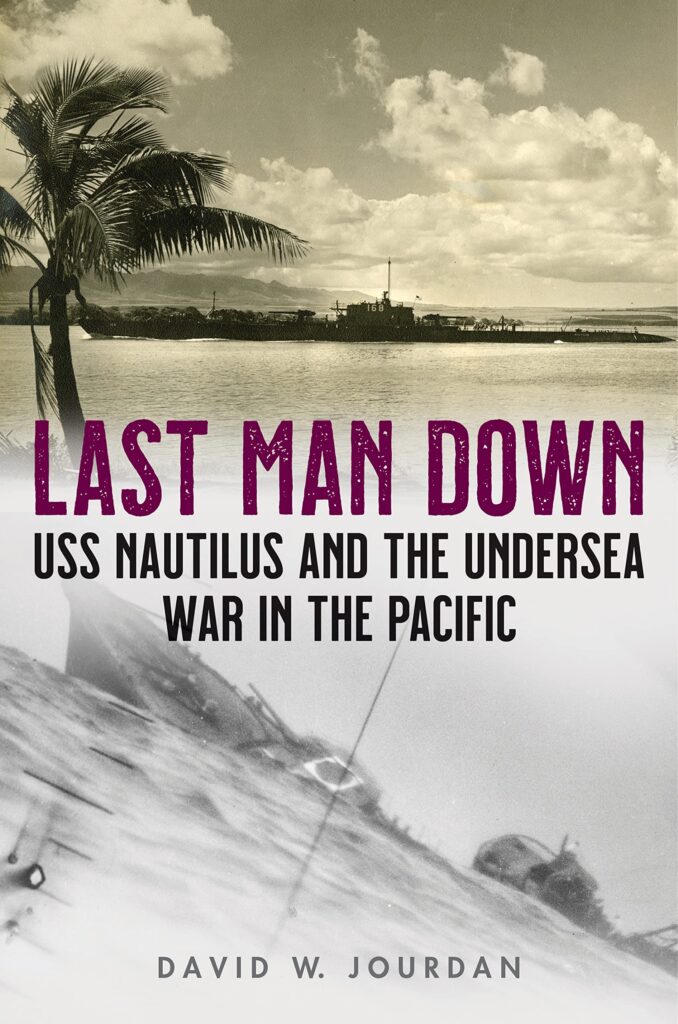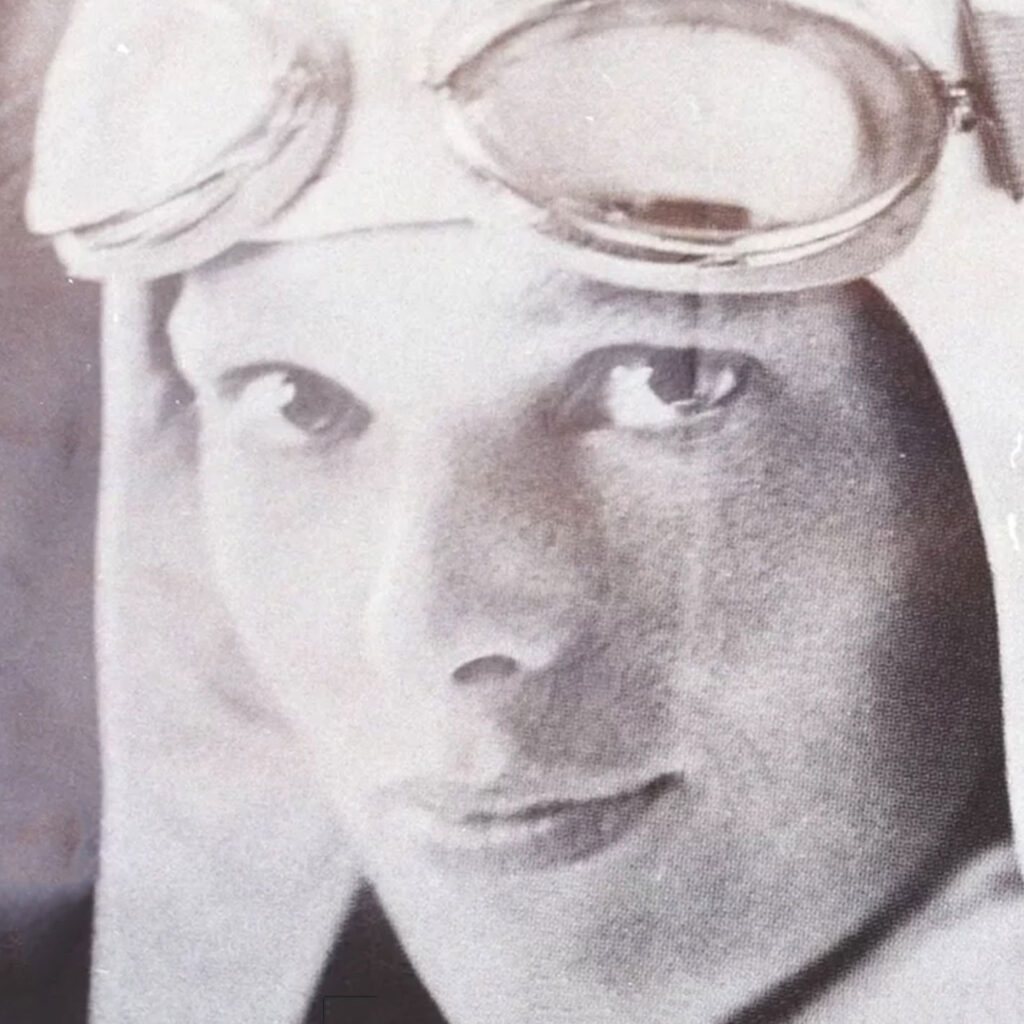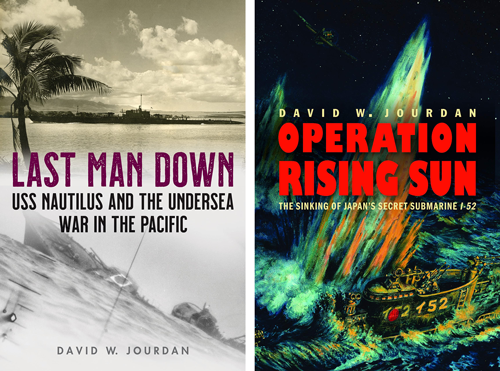New Book Last Man Down by David W. Jourdan
SS-168—USS Nautilus—was the pre-war flagship of Submarine Division 12 and operated out of Pearl Harbor throughout World War II. She was commissioned July 1, 1930, before international naval treaties limited future submarine size, and thus was among the largest submarines in the U.S. fleet. Over a football field in length and displacing 4,000 tons submerged, the boat was able to carry a large crew, ample cargo, two dozen torpedoes, cruiser-sized six-inch caliber guns, and cruise as far as 25,000 miles. She could dive to three hundred feet—though her crew was known to take her deeper. Throughout 1942-45 Nautilus engaged the enemy in fourteen war patrols, from the Battle of Midway to the liberation of the Philippines, earning fourteen battle stars and the U.S. Presidential Unit Citation. Her skipper, William H. Brockman, Jr., received not one but three Navy Crosses for heroism, the first for fighting through 42 depth charges at Midway. Nautilus did everything a submarine can do and was involved in most of the major actions of the Pacific theater. In Last Man Down, historical events documented in deck logs and patrol reports are told through the voices of the men who lived them.
Last Man Down
USS Nautilus and the Undersea War in the Pacific
by David W. Jourdan
Introduction
USS Nautilus (SS-168) was commissioned July 1, 1930, before international naval treaties limited future submarine size, and thus was among the largest submarines in the U.S. fleet. Over a football field in length and displacing 4,000 tons submerged, the boat was able to carry a large crew, ample cargo, two dozen torpedoes, cruiser-sized six-inch caliber guns, and cruise as far as 25,000 miles. She could dive to three hundred feet – though her crew was known to take her deeper.
SS-168 was the flagship of Submarine Division 12 operating out of Pearl Harbor, then a U.S. Territory. On May 24, 1942, Nautilus and her untested 93-man crew got underway for her first war patrol to Midway Island to help repel the expected Japanese attack. She returned to Midway on June 7, after shooting five torpedoes and having survived forty-two depth charges. As told in The Search for the Japanese Fleet, the dramatic tale of Nautilus and her actions during an eight-hour period early in that first patrol would rank among the most important contributions of a submarine to the most decisive engagement in U.S. Navy history.
Last Man Down continues the saga of the venerable warship and her service to our nation. Over her fourteen patrols through almost war’s end she sunk Japanese ships off Tokyo Bay; rescued civilians in the dead of night from enemy occupied islands; conducted reconnaissance ahead of the invasion of Tarawa; deployed commandoes to retake Attu in the Aleutians; and delivered vital supplies to resistance fighters in the Philippines. In short, Nautilus did everything a submarine can do and was involved in most of the major actions of the Pacific theater. Over the course of the war Nautilus traveled nearly 125,000 nautical miles, two-thirds of the way to the moon, which amounts to over 40,000 leagues under the sea.
In Last Man Down, historical events documented in deck logs and patrol reports are told through the voices of the men who lived them. Drawing on interviews with surviving crewmen (all since passed), contemporary writings, and consultation with family members, the story brings to life the drama of a torpedo attack, the fear of depth charging, the distress of evacuating wounded Marines, and the liveliness of R&R ashore in Australia. Major characters include a young sonar man who sat in the conning tower manning his gear during depth charge attacks, the gunnery officer whose periscope photos were featured in Life Magazine, a chief electrician who was on board for thirteen patrols, and the submarine’s most famous wartime skipper who earned the Navy Cross for heroism – three times.
Operation Rising Sun
The Sinking of Japan’s Secret Submarine I-52
by David W. Jourdan
In 1944 Allied codebreakers learned the Imperial Japanese Navy had dispatched the cargo submarine I-52 to occupied France with tons of military supplies and payment—in gold—for German assistance. I-52 undertook the mission as part of the Yanagi missions, a military program meant to alleviate Japan’s desperate need for military material and technical knowledge. After tracking I-52 from Asia to the Atlantic, the Allies destroyed the vessel in a battle that ended the Yanagi missions and left I-52 an unlikely treasure ship on the seafloor.
David W. Jourdan adds to the history of I-52 with a spellbinding account of his efforts to find the sunken submarine. One of the first joint American-Russian research expeditions, the search for the wreck combined a team effort, exhaustive detective work, and a dramatic battle with the sea. The effort paid off when the group found I-52’s nearly intact hull three miles down. The expedition also earned an unexpected historical dividend when it uncovered one-of-a-kind recordings of American Avenger torpedo bomber attacks on an enemy submarine.
Part war tale and part seagoing adventure, Operation Rising Sun tells the story of the two very different missions to find submarine I-52.
“Never Forgotten: The Search and Discovery of Israel’s Lost Submarine DAKAR”
by David W. Jourdan
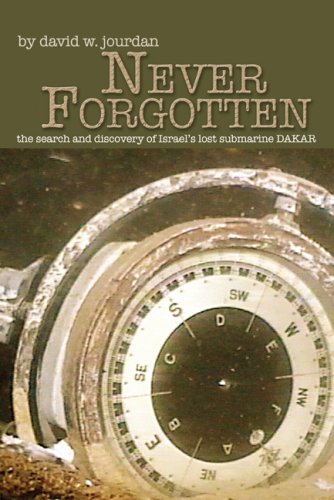
After the submarine DAKAR went down somewhere in the Mediterranean, Israel spent 31 years searching for the sixty-nine officers and crew. Newly purchased from the Royal Navy, along with two of her T-class sisters, she was commissioned into the Israeli Navy on 10 November 1967 as Dakar (“Swordfish” in Hebrew) and en route to Haifa after completing sea trails in England. On January 25 1968, two minutes after midnight, the Dakar transmitted her last communication Compelled by one of Israel’s strongest military traditions to bring home all killed and missing during battle for a proper Jewish burial, over 25 expeditions were launched and to search different areas of the Mediterranean. Imagine the national frustration of not being unable to find a massive 287-foot submarine that was lost for over 31 years, and not knowing the fate of the men of the DAKAR? This was the problem faced by the Israeli Navy in 1996 when it invited David Jourdan and his company Nauticos to conduct the search which led to discovery in May 1999. “NEVER FORGOTTEN: The Search and Discovery of Israel’s Lost Submarine DAKAR” tells the exhilarating story of the will, endurance, and technical know-how of extraordinary people who made a lifelong impact on an entire nation and sixty-nine grieving families. NEVER FORGOTTEN is a first-person account that grew directly from Jourdan’s successful career in deep-sea searches. The narrative follows the technological quest to locate the missing ship, 10,000 feet deep, and then try to discover the cause of the disaster. Included is the story of the DAKAR itself, beginning with its origins as the WWII British HMS TOTEM, through its sale to Israel, and the last, fateful voyage from which it never returned. Through it all we follow the families of the lost crew, from their pride in the DAKAR, to their horror of its loss, and their closure with the discovery of their loved ones’grave site. A dramatic final chapter imagines what the crew of the doomed submarine might have been doing in the final seconds before a massive implosion snuffed out their lives.While the exact cause of the loss is still unknown, it is likely that a catastrophic hull rupture occurred during a dive since it appears that no emergency measures had been taken before Dakar dove rapidly through her maximum depth. On 11 October 2000, Dakar’s bridge and forward edge of her sail were raised, and are now a memorial display in the Naval Museum in Haifa. Recover the remains of the crew members and giving them Jewish burial in Israel was finally abandoned, due to the enormous cost of such an operation and in deference to the long-standing maritime tradition of letting the sea bottom be the final resting place of drowned sailors. The crew members’ families had to content themselves with holding a ceremony in a ship over the submarine’s remnants.In the thirty-year period between the loss of the submarine and the final discovery of its remnants, various suppositions and Cold War conspiracy theories circulated. Many Israeli cities and towns have a Dakar Street, and several schools and other public institutions are also named for the lost submarine. “Full Circle,” a television documentary of the project was first aired on the National Geographic Channel in November of 2003, adding to public recognition of this event.
“The Deep Sea Quest for Amelia Earhart” Never Forgotten Book II
by David W. Jourdan

The disappearance of Amelia Earhart is possibly the greatest aviation mystery of the twentieth century. Amelia and her navigator, Fred Noonan, vanished without a trace in the vast Pacific near tiny Howland Island during their attempt to circle the globe on July 2, 1937. No wreckage, oil slick, or floating debris of any sort was ever found. Other than a few fleeting radio messages, there is no primary source to narrow speculation on their fate. Over the last decade, David W. Jourdan, founder of the deep-sea exploration company Nauticos, and Elgen Long, famed aviator and author of the book Amelia Earhart: The Mystery Solved (Simon and Schuster, 1999), have teamed with engineers, analysts, researchers, sponsors, and investors to begin the most extensive high-resolution mapping of the deep-ocean floor in history. During the course of this work, Jourdan and his team launched two seven-week expeditions, in 2002 and 2006, in a quest to find Amelia Earhart’s Lockheed Electra and put this mystery to rest. Locating such a small target in one of the deepest and most remote places on the planet was one of the most daunting quests ever faced by ocean explorers. It involved dramatic and sometimes life-threatening situations encountered over the course of weeks at sea, far from help or rescue. Deep-towed sonars were used to map underwater topography to one-meter accuracy over an area as large as the State of Rhode Island. Volcanic calderas, extensive ridge systems, and massive seamounts never before seen by humans were revealed as the team imaged terrain on earth’s final frontier. Deploying millions of dollars worth of equipment-spending a dollar every second-the expedition leaders and their supporters risked great fortune in the hopes of discovering an even greater historical treasure. The limits of equipment, endurance, nature, and even medicine were tested as the team pressed on.
The Battle of Midway as seen from the submarine Nautilus
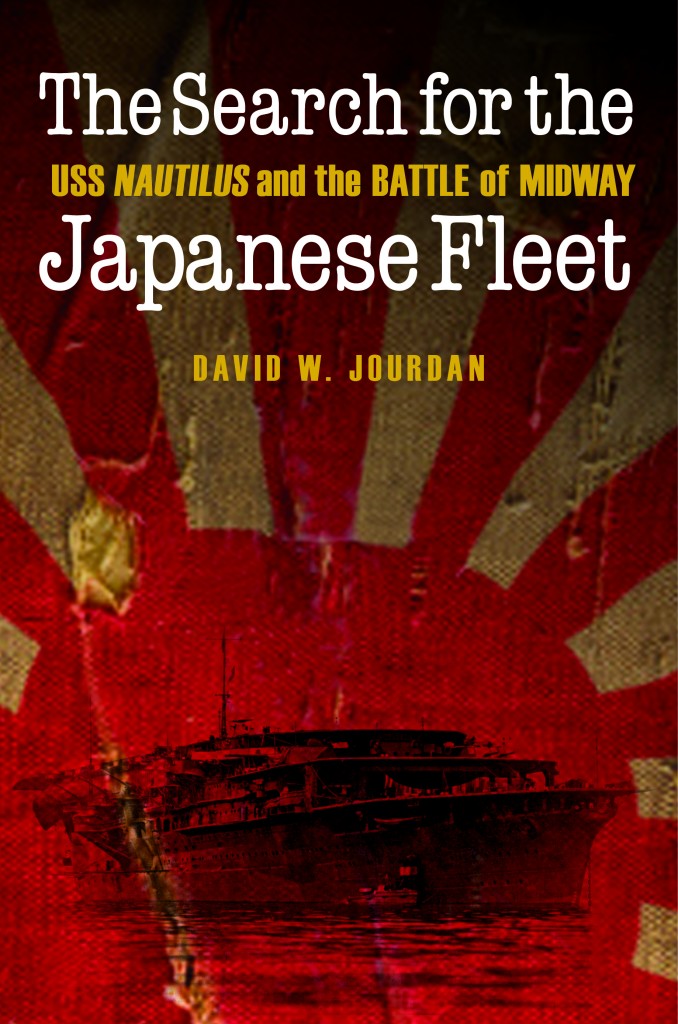
USS Nautilus and the Battle of Midway
by David W. Jourdan
Potomac Books. June 2015. 368 pp. 6 x 9.
$29.95* hardcover 978-1-61234-700-4
The Search for the Japanese Fleet
USS Nautilus and the Battle of Midway
David W. Jourdan
Foreword by Philip G. Renaud
“A superb combination of history, strategy, tactics, and science, David Jourdan’s new treatment of the epic Battle of Midway is a masterpiece. He takes us deep—both literally and figuratively—into acoustic exploration at sea, unlocks the mysteries of the undersea portion of Midway, and tells a gripping tale of war at sea in what many believe was the pivotal battle of the Pacific theater of World War II. An instant classic!”—Adm. James Stavridis, USN (Ret.), former supreme allied commander at NATO, 2009–13
“David Jourdan and his team discovered the sunken Japanese submarine I-52 and found the lost Israeli submarine Dakar, but could they find the Japanese carrier Kaga, sunk at the Battle of Midway when, despite the best efforts of others, its location remained a mystery? Two submarines, incredibly sharing the hull number 168, played key roles in the battle. One was Japanese, I-168, whose torpedoes sent the wounded Yorktown into the deep. The other was the American Nautilus (SS-168), which played a crucial role during the battle itself, and again, fifty-seven years later, in the hunt for Kaga. Jourdan brings both to life in this fascinating account.”— Vice Adm. George W. Emery, USN (Ret.), former commander U.S. and allied submarine commands, Atlantic
In The Search for the Japanese Fleet, David W. Jourdan, one of the world’s experts in undersea exploration, reconstructs the critical role one submarine played in the Battle of Midway, considered to be the turning point of the war in the Pacific. In the direct line of fire during this battle was one of the oldest boats in the navy, USS Nautilus. The actions of Lt. Cdr. William Brockman and his ninety-three-man crew during an eight-hour period rank among the most important submarine contributions to the most decisive engagement in U.S. Navy history.
Fifty-seven years later, Jourdan’s team of deep-sea explorers set out to discover the history of the Battle of Midway and find the ships that the Allied fleet sank. Key to the mystery was Nautilus and its underwater exploits. Relying on logs, diaries, chronologies, manuals, sound recordings, and interviews with veterans of the battle, including men who spent most of June 4, 1942, in the submarine conning tower, the story breathes new life into the history of this epic engagement. Woven into the tale of World War II is the modern drama of deep-sea discovery, as explorers deploy new technology three miles beneath the ocean surface to uncover history and commemorate fallen heroes.

